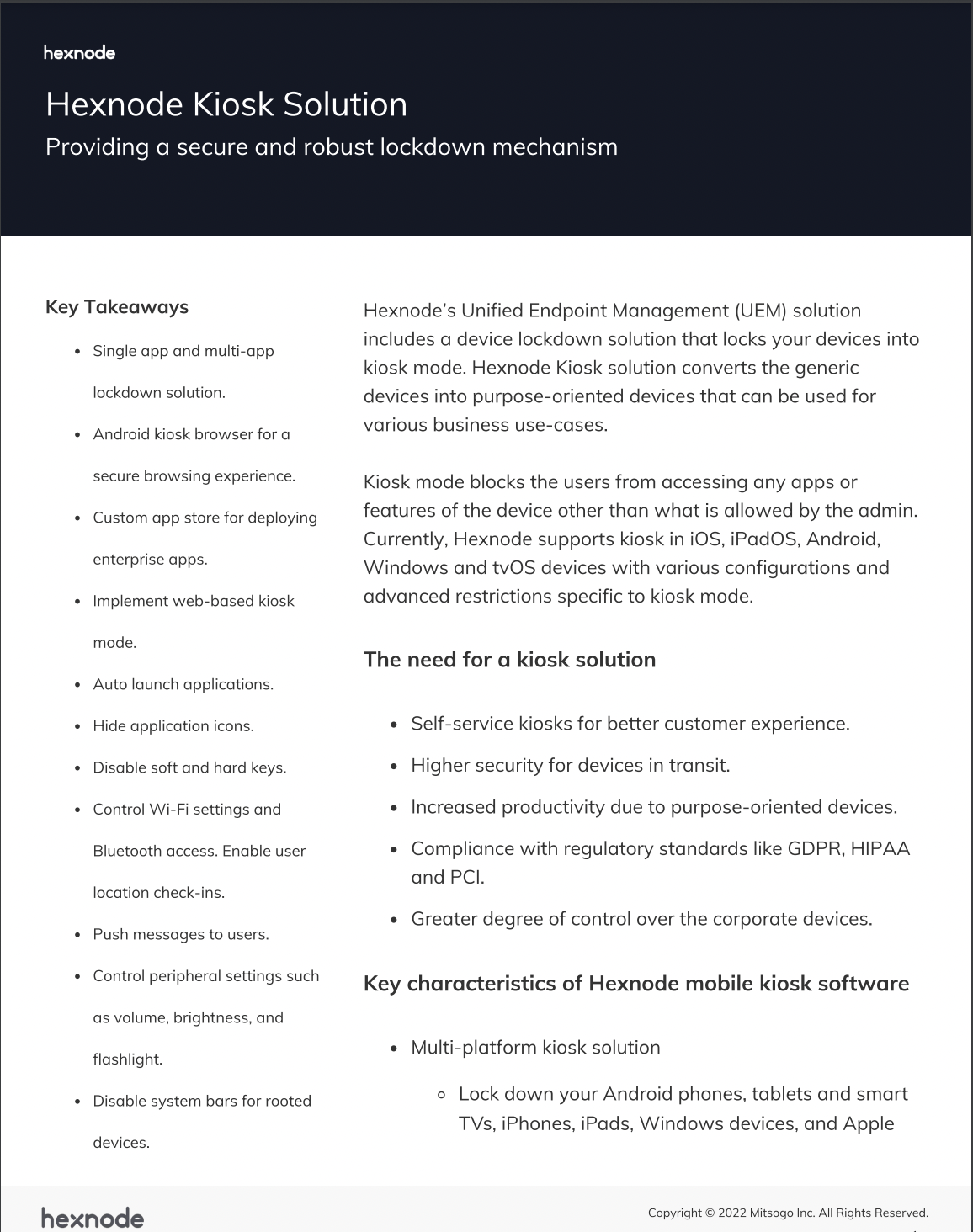How many times have you been amazed by the self-order devices you see at restaurants and cafes? With the press of a few buttons, you get the food you like minutes after you use it. These devices found themselves extremely handy when covid hit the entire world.
Have you ever wondered how they work, or what these devices are? Well, they are essentially devices that are locked down to a single app. Ok, that was just one example of a device locked in single app mode. ATMs, any kind of PoS devices, any kind of digital advertisements, and so on come under one umbrella, that is devices in single app mode. The applications of single app kiosks are endless.
What is single app-mode?
For those of you who don’t know what a single app mode or single app kiosk is, it is a device that is locked down to a single app and only that app can be used on that device until the mode is switched off. Background processes will continue to function, but for certain features of some apps to work, apps like gallery and contacts must be granted permission to run in the background. So, devices locked in single app mode can be used only for the intended use and nothing else. As a result, the device has both advantages and disadvantages.
Advantages
The major advantage of such devices is that they are extremely safe to use. That is why companies use kiosk devices for public use, where a lot of people use the device. And since no other apps can be installed or run while the device is in single app mode, the risk of rouge apps causing problems can also be eliminated.
The next advantage of devices locked in single app mode is that these devices are perfect for applications where high productivity is required. This is because the employees can’t do anything apart from the intended task on the device. In that way, time spent on unnecessary activities can be minimized. An example of such a situation is a shipping warehouse, where even a small delay can cause a huge loss.
With the rise of kiosk software and Unified Endpoint Management (UEM) solutions that offer kiosk capabilities, it is now possible to lock down normal devices to kiosk modes. This saves a lot, in terms of money, since specialized kiosk devices won’t have to be purchased for every kiosk application.
Disadvantages
Okay now coming to disadvantages, without the right tool, it might be a bit difficult to change the app from time to time. Another one is that if the device runs into a problem, it might take a bit of time to fix it and re-deploy it. So constant monitoring is necessary to ensure that the kiosk is functioning properly.
What are the industrial applications of single app kiosks?
As we mentioned above single app kiosks are finding their way into a lot of industries, not just the hospitality industry. Even in sectors like healthcare, logistics and transport, education, retail and banking, single app kiosks are extremely popular.
The healthcare industry is using single app-kiosks for applications like patient monitoring purposes and self-help stations for patients to book appointments, pay bills and take reports. In the case of sectors like logistics, education and transport, the main use of single app mode is to lock employee devices in a single app to ensure the highest rates of productivity.
The retail industry has extensive use for PoS devices, which is essentially single app devices. And as mentioned in the beginning, banks are making use of single app mode to power their ATMs, self-help kiosks, and feedback booths.
Why should you consider Windows devices for single app mode?
The reason is pretty obvious, right? Windows devices are something we all grew up using. And their best-selling point was always the ease with which they could be used. Since they are easy to use for normal applications, why not use them for kiosk applications too?
Another thing about Windows devices is that they are very affordable. Compared to other computers, Windows devices have a lot of options and based on the budget it is easy to get a good PC that fits every requirement.
Then last but certainly not least, is the ease of management. This is something that excites enterprises to take Windows devices for any kind of application. With Windows devices, every nook and cranny of the device can be managed with the right tool. I think that is enough to convince any company to consider Windows devices as an option for their kiosk requirements.
How to lock down Windows devices in single app mode?
Windows has provided its users with multiple ways in which they can lock down their devices in single app mode. All of these modes make use of a feature called Assigned Access to lock down the device in single app mode. To read more about the Assigned Access mode, click here.
There are mainly three ways you can do this without using kiosk software, and to proceed with any of these the device should be running on Windows 10 or above.
Locally using the settings
Using the settings on the device, you can lock down a device in single app mode. The process is a bit different for devices before and after Windows 10 version 1809.
For Windows 11 or Windows 10 version 1809
To lock down a device in single app mode using the settings, you have to create an account first, which will be the kiosk account. Following are the steps to set up single app mode:
- Start the Settings app and select Accounts. Choose Other users or Family and other users.
- Choose Set up a kiosk > Assigned access, then click Get started.
- Give the new account a name.
- Select which app will launch when the kiosk account logs in. The list of available apps will only include apps that can operate above the lock screen. Click here for more information on choosing an app for Assigned Access.
- Click on Close.
- Choose the account tile on the Set up a kiosk screen, followed by Delete kiosk, to remove single app mode.
For Windows 10 version 1809 and below
To lock down a device in single app mode using the settings, you must have an existing local standard user account, which will be the kiosk account. Following are the steps to set up single app mode:
- Choose Other People under Accounts in Start > Settings > Accounts.
- Select Set up assigned access.
- Click on an account.
- Select an app. The list of available apps will only include apps that can work above the lock screen. Click here for more information on choosing an app for Assigned Access.
- Close Settings- Your selections are immediately saved and will be taken into account the next time the person logs in.
- By selecting Turn off assigned access and logging out of the chosen account, you can remove single app mode.
Using PowerShell
Multiple PowerShell commands can be used to set up single app mode on a single device or multiple devices. But before you can do that, you have to take care of a few other things:
- Sign in as administrator.
- Create the user account for Assigned Access.
- Log in using the user account with Assigned Access.
- Download and install the Universal Windows app that complies with the assigned access/above the lock rules.
- Leave the Assigned Access user account by signing out.
- Sign in as administrator.
You can use the search bar to find the Windows PowerShell Desktop app. Run the app as administrator. This is where you run your PowerShell commands to lock down the device in single app mode. These are the commands you can use to lock your device in single app mode:
- Configure assigned access by AppUserModelID and username:
1Set-AssignedAccess -AppUserModelId <AUMID> -UserName <username>
- Setup assigned access by AppUserModelID and user SID:
1Set-AssignedAccess -AppUserModelId <AUMID> -UserSID <usersid>
- Configure assigned access by app name and username:
1Set-AssignedAccess -AppName <CustomApp> -UserName <username>
- Setup assigned access by app name and user SID:
1Set-AssignedAccess -AppName <CustomApp> -UserSID <usersid>
- To exit from the single app mode use the following command:
1Clear-AssignedAccess
Using the kiosk wizard in Windows Configuration Designer
To get started with this make sure that you have the Windows Configuration Designer installed on your device. After that, select the “Provision kiosk devices” from the app and name your project and proceed to configure the settings.
- Switch on device setup and enter the details and set up the settings that pop up.
- Configure the network.
- Enable the account management setting and fill in the required details.
- Add the app to which you want the device to be locked in.
- Add the security certificate.
- Configure the kiosk account using the “Create a kiosk user account” setting.
- Configure the common kiosk settings like “Set tablet mode”, “Customize user experience” and “Configure power settings”.
- Select finish and protect your provisioning package with a password of your liking.
Why use Hexnode to enable Windows single app mode?
Apart from all the ways Windows offers, you can also use kiosk software or a powerful UEM like Hexnode to lock down your Windows devices in kiosk mode. But you might be wondering, if Windows is offering all these methods, then why use a third-party tool like Hexnode to do it?

Featured resource
Hexnode Kiosk Solution
Hexnode’s Kiosk solution helps you convert your devices into purposed devices, securing corporate data within an enterprise network. Get started with Hexnode’s Kiosk solution to create your purpose-specific environment while securing your corporate data.
Download the datasheetWell, from what you have read till now, it might be pretty clear that the process is not straightforward. It takes patience and a lot of time and effort to lock Windows devices in single app mode.
With Hexnode, it takes just a few easy steps to lock your devices in single app mode. And once locked, you can manage and monitor the device using Hexnode which is like a bonus for enterprises.
You can also deploy apps and device configurations in the background through Hexnode. Using Hexnode to lock down your Windows devices is like an added layer of security since the only way to exit from the single app mode is to disable it using the Hexnode console or using the code which is generated in the Hexnode console.
How to setup Windows single app mode?
To set up a Windows device in single app mode using Hexnode, you first have to enroll the device in the management console. Click here to know more on how to enroll Windows devices into Hexnode management console.
The second step is to create a local account in the device, this account will act as the kiosk account. Once that is done, install the app which is to be used to lock the device in single app mode in the kiosk account.
Once these things are done, you can create a kiosk policy using Hexnode. For that you have to enter in the kiosk name, choose the app and apply the policy to the target device. Well, you might be a bit confused as to where these things are to be configured. To know more about Windows kiosk mode and how Hexnode helps configure it, click here.
In conclusion,
Well, that was quite a read, wasn’t it? But with all that knowledge, you are now completely capable of turning any innocent Windows 10 or above devices into an all-powerful single app mode. Not just that, you now know all the pros and cons of single app mode, why Windows is the perfect device for your single app mode needs and how to use a powerful UEM like Hexnode to do the job. What are you waiting for? Start locking your Windows devices in single app mode now.
Try out Hexnode for free!
Sign up for a free trial and try out Hexnode's Windows management capabilities.
Sign up




